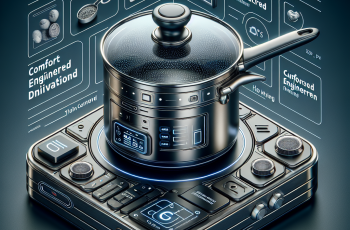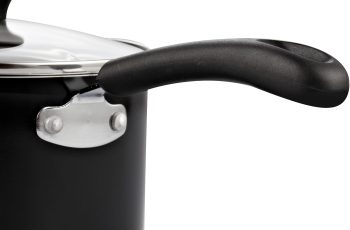Ad Blocker Detected
Our website is made possible by displaying online advertisements to our visitors. Please consider supporting us by disabling your ad blocker.
In the culinary world, the humble saucepan often takes a backseat to flashier kitchen utensils and appliances. However, its significance in various cuisines should not be underestimated. This article explores the pivotal role that the saucepan plays in cooking techniques and traditions around the world. From simmering delicate sauces to preparing hearty stews, the saucepan serves as a versatile tool that allows chefs and home cooks alike to achieve flavor and texture perfection. Join us as we uncover the secrets and techniques behind the influential role of the saucepan in various global cuisines.
The Role of the Saucepan in Various Cuisines
Introduction to the Saucepan
The saucepan is a versatile and essential kitchen tool that plays a crucial role in various cuisines around the world. This cooking vessel with high, straight sides and a long handle is designed to accommodate a range of cooking techniques, making it a staple in both home kitchens and professional culinary settings. From simmering and stewing to sautéing and frying, the saucepan offers unparalleled control and efficiency, ensuring optimal results in a wide array of dishes.
Types of Saucepans
Saucepans come in different materials and sizes to cater to different cooking preferences and needs. The most common materials used for saucepans are stainless steel, copper, and non-stick coatings. Stainless steel saucepans are durable, heat-resistant, and easy to clean. Copper saucepans, on the other hand, excel in heat conductivity, providing precise temperature control. Non-stick coated saucepans are popular for their convenience and easy food release.
When selecting a saucepan, it is essential to consider the size. They usually range from 1-quart to 4-quart capacities, with larger sizes available for commercial use. It is recommended to have a few saucepans of varying sizes in your kitchen, allowing for versatility in cooking different dishes.
Traditional Cuisines and Their Saucepan Usage
1. Italian Cuisine
In Italian cuisine, the saucepan holds a significant role in the preparation of many iconic dishes. From preparing tomato-based pasta sauces to simmering risottos, the saucepan allows for slow cooking while preserving the flavors of the ingredients. Italians rely on the saucepan to create rich and flavorful sauces, often combining fresh vegetables, herbs, and meats to develop complex flavors.
2. French Cuisine
French cuisine is renowned for its sophisticated sauces and delicate preparations. The saucepan’s versatility is especially valued in French cooking, where it is used for everything from making delicate butter-based sauces to slow-cooking stews like Coq Au Vin. The saucepan’s ability to evenly distribute heat and maintain a steady temperature is crucial in achieving the precise control required for French culinary techniques.
3. Chinese Cuisine
In Chinese cuisine, the wok is the primary cooking vessel, but the saucepan still has its place in the kitchen. It is commonly used for making soups, such as hot and sour soup or egg drop soup. The saucepan’s high sides allow for the preparation of generous portions of soup, while its even heat distribution ensures even cooking. Additionally, the saucepan is utilized for stir-frying sauces and preparing marinades, showcasing its adaptability in Chinese cuisine.
Modern Cuisines and Their Saucepan Usage
1. Asian Fusion Cuisine
Asian fusion cuisine combines various culinary traditions with ingredients and techniques from different parts of Asia. The saucepan is a valuable tool in this style of cooking, as it allows chefs to effortlessly blend flavors and create harmonious dishes. From stir-frying Asian-inspired sauces to simmering fusion soups and stews, the saucepan’s versatility fits perfectly into the creative and innovative realm of Asian fusion cuisine.
2. Mediterranean Cuisine
Mediterranean cuisine, known for its emphasis on fresh ingredients and bold flavors, also embraces the use of saucepans. From slow-cooking rich tomato-based pasta sauces to preparing classic dishes like paella, the saucepan is a vital instrument in Mediterranean cooking. Its ability to maintain a gentle simmer or a rolling boil makes it the ideal vessel for bringing together the vibrant flavors of the Mediterranean.
3. Mexican Cuisine
In Mexican cuisine, saucepans are a staple when it comes to preparing traditional dishes. From simmering flavorful salsas and mole sauces to boiling beans and cooking rice, the saucepan’s versatility shines through in Mexican cooking. The saucepan’s deep sides and even heat distribution make it an essential tool in crafting the authentic flavors and textures of Mexican cuisine.
Saucepan Techniques and Recipes
1. Simmering and Stewing
Simmering and stewing are popular techniques used with saucepans, particularly in dishes that require longer cooking times. Simmering involves cooking food gently in liquid at a temperature just below boiling. This technique is commonly used for preparing stocks, soups, and stews, allowing flavors to meld and intensify over time. Stewing, on the other hand, involves cooking food in a small amount of liquid for an extended period, resulting in tender and flavorful dishes. A classic recipe that showcases these techniques is the hearty beef stew, where the saucepan is utilized to create a savory broth and tenderize the meat.
2. Sauteing and Frying
Sauteing and frying are techniques that allow for quick and flavorful cooking. Sauteing involves quickly cooking ingredients in a small amount of fat over high heat, resulting in enhanced flavors and a caramelized exterior. The saucepan’s high sides prevent ingredients from spilling out, while its even heat distribution ensures uniform cooking. Frying, on the other hand, involves immersing ingredients in hot oil or fat until they are crispy and golden. The deep sides and ample capacity of the saucepan make it a suitable vessel for shallow frying, such as making crispy chicken cutlets.
3. Boiling and Blanching
Boiling and blanching are techniques commonly used for cooking vegetables, pasta, and grains. Boiling involves immersing food in a liquid at its boiling point, while blanching refers to briefly boiling food before shocking it in ice water to halt the cooking process. The saucepan’s large capacity and efficient heat distribution make it an excellent tool for boiling water quickly and evenly. It is often used in pasta dishes and vegetable preparations, where precise timing is essential to achieve the desired texture and doneness.
4. Making Sauces and Soups
The saucepan is especially crucial in the creation of sauces and soups. Whether it’s a velvety béchamel sauce or a hearty tomato soup, the saucepan allows for the gradual reduction and concentration of flavors. Its high sides prevent splattering while the even heat distribution ensures that the sauce or soup cooks evenly. This versatile cookware is also ideal for making condiments like caramel or chocolate sauces, providing precise temperature control and preventing scorching.
Conclusion
The saucepan’s role in various cuisines cannot be understated. From traditional cuisines like Italian, French, and Chinese, to modern culinary expressions like Asian fusion, Mediterranean, and Mexican, the saucepan serves as a reliable tool for countless recipes and techniques. Its versatility, heat distribution, and control allow chefs and home cooks alike to create flavorful sauces, hearty stews, delicate soups, and so much more. The saucepan truly is an indispensable companion in the kitchen, continually connecting diverse cuisines and enhancing the art of cooking.

